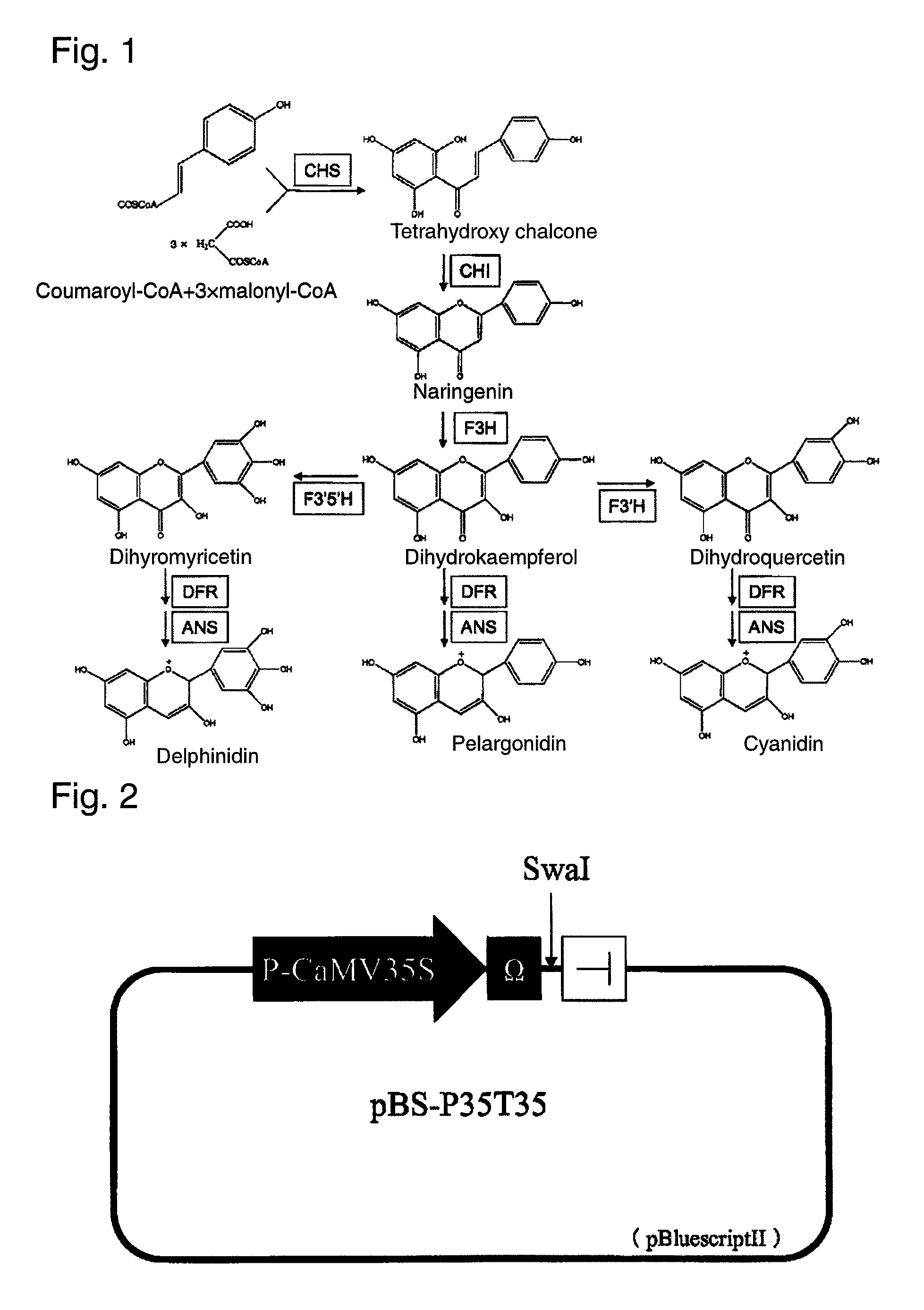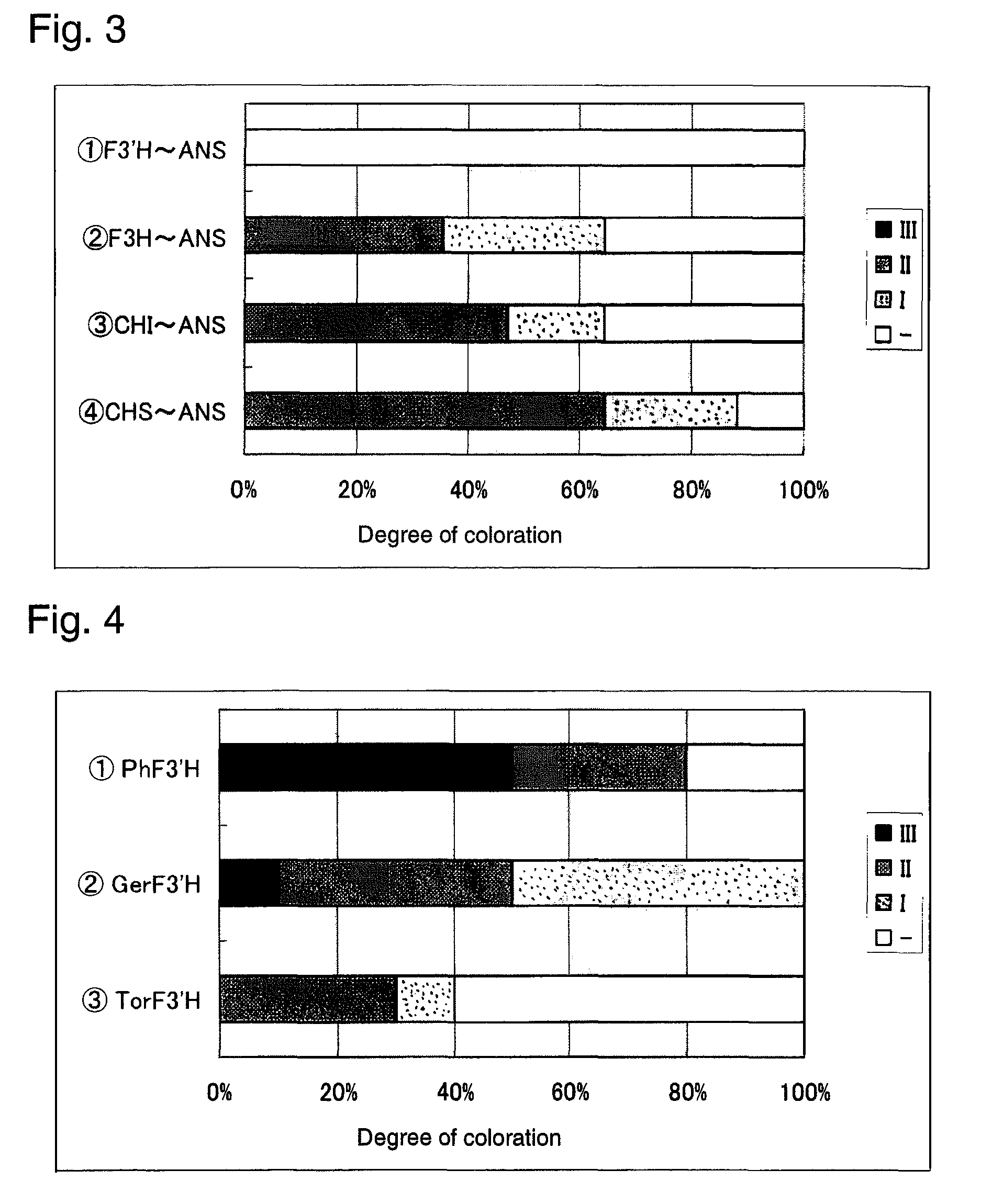Method for production of moth orchid having modified flower color
a moth orchid and flower color technology, applied in the field of moth orchid flower color modification, can solve the problems of not being able to produce a variety with a desired character only through cross breeding, not being able and being unable to achieve the desired color of the flower of the moth orchid, so as to maintain the superiority of other characters
- Summary
- Abstract
- Description
- Claims
- Application Information
AI Technical Summary
Benefits of technology
Problems solved by technology
Method used
Image
Examples
example 1
Transfection of a Petal of Moth Orchid with a Gene
[0057]Unless otherwise specified in Examples of the present specification, petals of moth orchid were transfected with the various genes by the following gene transfection method, and their property was evaluated. All genes had a DNA structure having a promoter at 5′ side and a terminator at 3′ side and were introduced into petal cells in a form expressible in the cells.
[0058]A bud of moth orchid was sterilized with a 1 wt % of sodium hypochlorite aqueous solution for five minutes and washed with sterilized water 3 times. Then, the bud was resolved into a lateral sepal, dorsal sepal and petal, and the lateral sepal, dorsal sepal and petal were left on an agar medium containing NDM salt (Tokuhara and Mii, Plant Cell Reports (1993) 13: 7-11.) and 0.6 wt % agarose. Herein, a bud having a length of about 15 mm of a white moth orchid Phal. amabilis was used.
[0059]DNA to be introduced was purified by using Hi Speed Plasmid Midi Kit (QIAGEN...
example 2
Preparation of an Expression Vector (pBS-P35T35) for Gene Transfection
[0060]pBS-P35T35 is a plasmid having the cauliflower mosaic virus 35S promoter (Hohn et al., Curent Topics in Microbiology and Immunology (1982) 96: 194-236), an omega sequence of tobacco mosaic virus (Gallie et al., Nucleic Acids Research (1987) 15: 3257-3273), a restriction endonuclease SwaI site and the cauliflower mosaic virus 35S terminator in this order in pBluescriptIISK—(Stratagene) (FIG. 2). A plasmid having substantially the same function as pBS-P35T35 can be constructed as follows.
[0061]An oligonucleotide SAS-S (5′-CTAGCTAGCGGCGCGCCTGCAGGATATCATTTAAATCCCGGG-3′; SEQ ID NO: 17) and an oligonucleotide SAS-AS (5′-CCCGGGATTTAAATGATATCCTGCAGGCGCGCCGCTAGCTAG-3′; SEQ ID NO: 18) were thermally denatured, then gradually cooled to room temperature and treated with NheI, and the resulting fragment was ligated between the XbaI-EcoRV sites of pBluescriptIISK—(Stratagene) to prepare a plasmid DNA with a modified restr...
example 3
Isolation of the Moth Orchid CHS, CHI, F3H, F3′H, DFR and ANS Genes and Preparation of DNA for Transient Expression
(1) Isolation of the Moth Orchid CHS Gene (PhCHS3)
[0063]Total RNA was isolated from petals of moth orchid (Dtps. Sogo Vivien×Dtps. Sogo Yenlin) just before flowering by using RNeasy Plant Mini Kit (QIAGEN) and used as the template to prepare cDNA by SuperscriptII First-Strand Synthesis System (Invitrogen). Then, RT-PCR was carried out by using this cDNA as the template. In the PCR, PhCHS3 F1 (5′-AAGCTTGTGAGAGACGACGGA-3′; SEQ ID NO: 21) and PhCHS3 R1 (5′-TGGCCCTAATCCTTCAAATT-3′; SEQ ID NO: 22) designed from a known moth orchid CHS gene (PhCHS) sequence (GenBank accession No.: DQ089652) were used as the primers. The reaction was carried out by repeating a step of 94° C. for 30 seconds, 55° C. for 30 seconds and 72° C. for 1 minute 25 cycles. Amplification was carried out again in the same reaction solution under the same conditions again using the reaction product as the ...
PUM
| Property | Measurement | Unit |
|---|---|---|
| Color | aaaaa | aaaaa |
Abstract
Description
Claims
Application Information
 Login to View More
Login to View More - R&D
- Intellectual Property
- Life Sciences
- Materials
- Tech Scout
- Unparalleled Data Quality
- Higher Quality Content
- 60% Fewer Hallucinations
Browse by: Latest US Patents, China's latest patents, Technical Efficacy Thesaurus, Application Domain, Technology Topic, Popular Technical Reports.
© 2025 PatSnap. All rights reserved.Legal|Privacy policy|Modern Slavery Act Transparency Statement|Sitemap|About US| Contact US: help@patsnap.com



